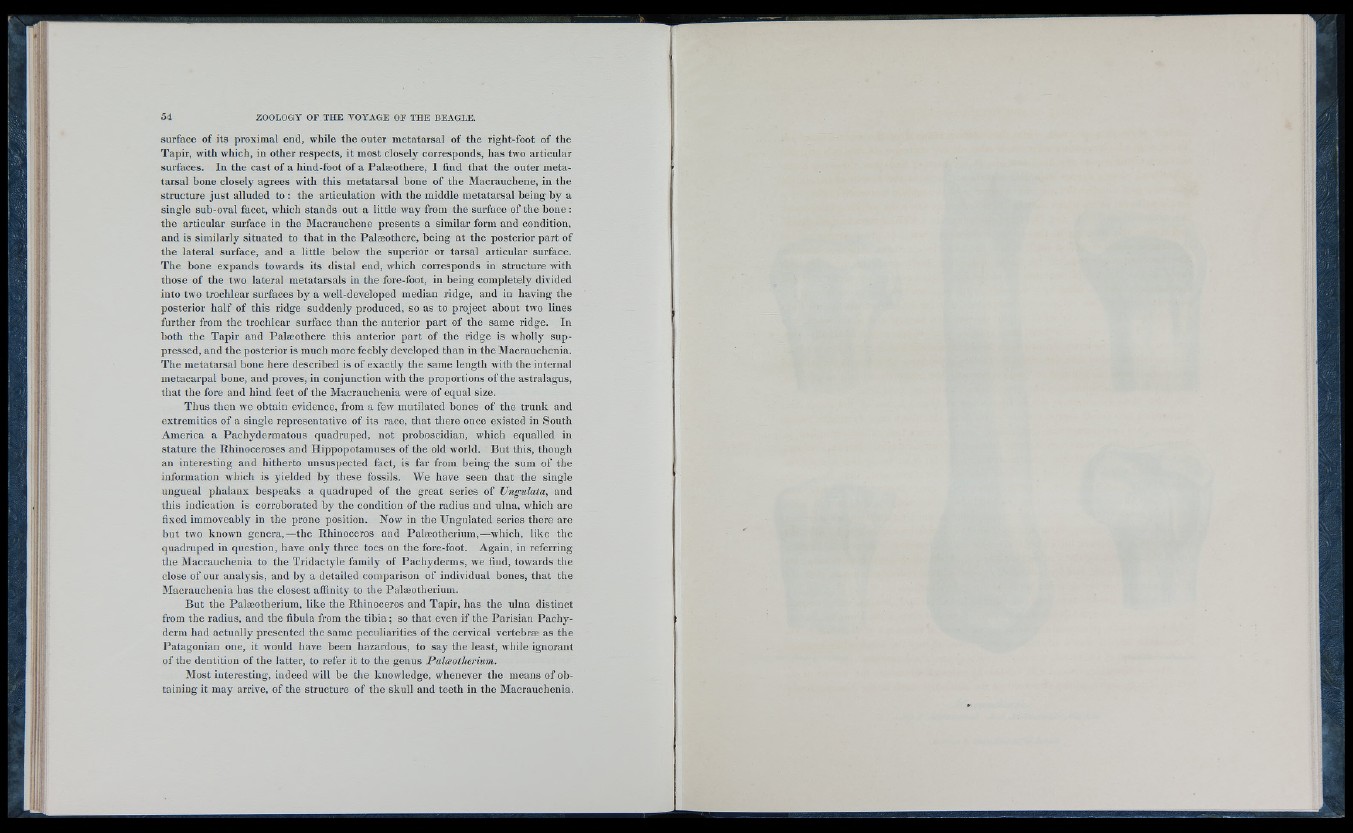
surface of its proximal end, while the outer metatarsal o f the right-foot o f the
Tapir, with which, in other respects, it most c lo se ly corresponds, has two articular
surfaces. In the cast o f a hind-foot o f a Palæothere, I find that the outer metatarsal
bone c lose ly agrees with this metatarsal bone o f the Macrauchene, in the
structure ju s t alluded to : the articulation with the middle metatarsal being by a
sing le sub-oval facet, which stands out a little way from the surface of the bone :
the articular surface iu the Macrauchene presents a similar form and condition,
and is similarly situated to that in the Palæothere, being at the posterior part o f
the lateral surface, and a little below the superior or tarsal articular surface.
The bone expands towards its distal end, which corresponds in structure with
those o f the two lateral metatarsals in the fore-foot, in being completely divided
into two trochlear surfaces b y a well-developed median ridge, and in having the
posterior h a lf o f this ridge suddenly produced, so as to project about two lines
further from the trochlear surface than the anterior part o f the same ridge. In
both the Tapir and Palæothere this anterior part o f the ridge is wholly suppressed,
and the posterior is much more feebly developed than in the M acrauchenia.
The metatarsal bone here described is o f ex a c tly the same length with the internal
metacarpal bone, and proves, in conjunction with the proportions o f the astralagus,
that the fore and hind feet of the Macrauchenia were o f equal size.
Thus then we obtain evidence, from a few mutilated bones o f the trunk and
extremities o f a sing le representative o f its race, that there once existed in South
America a Pachydermatous quadruped, not proboscidian, which equalled in
stature the Rhinoceroses and Hippopotamuses o f the old world. But this, though
an interesting and hitherto unsuspected fact, is far from being the sum o f the
information which is yielded by these fossils. We have seen that the single
ungueal phalanx bespeaks a quadruped o f the great series o f Vngulaia, and
this indication is corroborated by the condition o f the radius and ulna, which are
fixed iminoveably in the prone position. Now in the Ungulated series there are
but two known genera,—the Rhinoceros and Palæotherium,—wliich, lik e the
quadruped in question, have only three toes on the fore-foot. Again, in referring
the Macrauchenia to the Tridactyle family o f Pachyderms, we find, towards the
close o f our analysis, and by a detailed comparison o f individual bones, that the
Macrauchenia has the closest affinity to the Palæotherium.
B u t the Palæotherium, lik e the Rhinoceros and Tapir, has the ulna distinct
from the radius, and the fibula from the tibia ; so that even if the Parisian P a ch y derm
had actually presented the same peculiarities o f the cervical vertebræ as the
Patagonian one, it would have been hazardous, to say the least, while ignorant
o f the dentition o f the latter, to refer it to the genus Paloeoiherium.
Most interesting, indeed will be the knowdedge, w’henever the means o f obtaining
it may arrive, o f the structure o f the skull and teeth in the Macrauchenia.